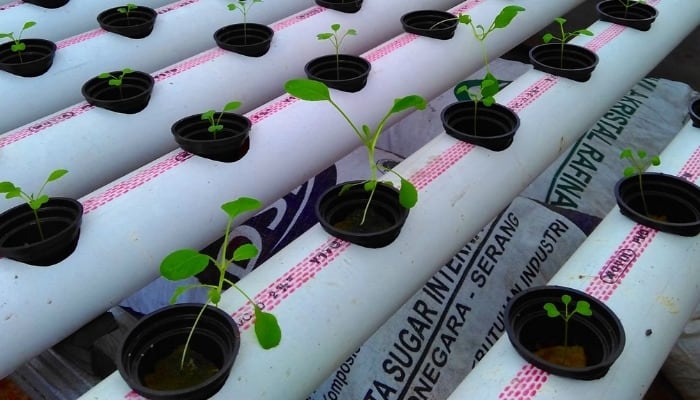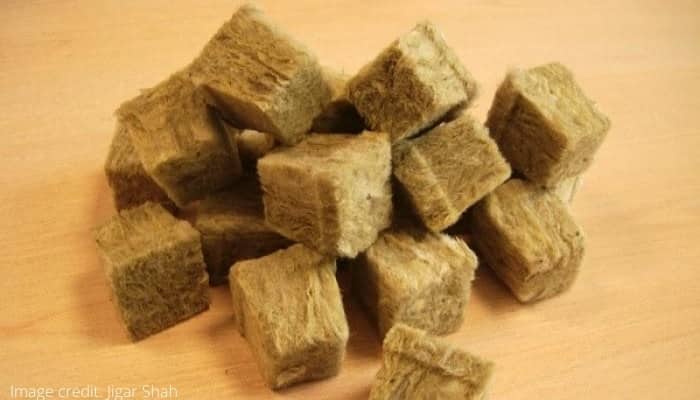Using Rockwool cubes for hydroponic gardening is a commonly accepted practice, especially for newcomers to the hydroponic gardening world who may have inquiries regarding these enigmatic stone-like cubes.
How to use rockwool in hydroponics? Using rockwool cubes is simple: soak them, put seeds inside, and keep them moist. After several days or weeks, seedlings are ready for transplanting into a hydroponic growing system. Plug the rockwool cubes, plant and all, directly into your grow sites, and you’re done!
Read on below to discover everything there is to know about using Rockwool cubes!
Rockwool Cubes for Hydroponics
In hydroponics, few components are as small and seemingly insignificant as rockwool cubes, but the truth is that these little rock-based seed-starters are a game-changer for starting and growing hydroponic plants.
In the following sections, we break down every little aspect of rockwool cubes, including what they are, what sizes they come in, how to use them, and much more.
What Are Rockwool Cubes?
Rockwool cubes are a specific form of the popular growing medium known as rockwool or stonewool. The purpose of rockwool cubes is to germinate seeds and plant/root cuttings.
These cubes consist of various types of stonewool formed into rudimentary cubes. They are available in multiple sizes.
Rockwool Cube Sizes
Generally speaking, the most common sizes for rockwool cubes (in inches) are 1 x 1 x 1.5, 1 x 1.5 x 1.5, 2 x 2 x 1.5.
Extra-large rockwool cubes are also available in sizes ranging from 3 inches to over 4 inches. Depending on where you buy your rockwool cubes, sizes may vary.
Rockwool Cubes Water Retention
The water retention of rockwool cubes is excellent, if not unique. The cubes collect water, mainly in the bottom of the cube and allow plenty of airflow through the rest of the cube.
Thanks to its incredible wicking properties, it’s no problem for roots to suck up moisture through the cube as needed.
Rockwool Cubes Air Flow
One of the best features of rockwool cubes is their amazing airflow, especially in comparison to other growing medium and seed-starting systems.
Even when oversaturated with water and nutrients, rockwool cubes still have around 20% or more airflow.
Are Rockwool Cubes Safe?
Rockwool may be seen as slightly controversial to some gardeners as it could be considered potentially dangerous if breathed in.
However, as a substrate, germination tool, and rooting agent, rockwool cubes are absolutely natural and safe.
Is Rockwool Organic?
Rockwool is a rock-based mineral fiber consisting of basalt and slag. Rockwool cubes are considered a natural product because they are used strictly for horticultural purposes.
How Long Do Rockwool Cubes Last?
Rockwool cubes last quite a bit longer than most similar products, especially the organic ones that are made for one-time use.
Because of their stone-like makeup, rockwool cubes may last as much as several years.
Can Rockwool Cubes Be Reused?
You may have already guessed, but, yes, rockwool cubes can indeed be reused. In fact, many gardeners use their cubes up to five or six times on average.
If you’re really careful or on a tight budget, you may even get eight or nine plants started per cube.
What Can I Grow With Rockwool Cubes?
Truth be told, there isn’t much that you can’t start/grow with rockwool cubes.
Some of the most popular garden variety plants started/grown with rockwool cubes include tomatoes, peppers, cucumbers, melons, strawberries, basil, mint, and more.
Many flowers and houseplants can also grow in rockwool cubes.
Should Rockwool Cubes Be Soaked in Nutrient Solution?
Depending on the crop you are germination in rockwool, the cubes may indeed benefit from a nutrient soak prior to filling them with seeds.
A broad-application, organic-based nutrient solution such as Botanicare Pure Blend Pro, is ideal.
Without being treated, rockwool cubes have a natural pH of between 6.0 and 7.0.
How Long Should I Soak Rockwool Cubes?
Rockwool cubes benefit the most from soaking for an hour or longer.
That said, be sure to consider the type of plants you are germinating and what their preferred pH level is. If it’s higher than usual, a shorter soak will do.
Do Seeds in Rockwool Need Light?
The type of seeds you are attempting to germinate dictates whether the rockwool cubes need light or darkness.
Most seeds prefer dark and dry environments with regular misting to germinate. Some plants, however, like begonias, indeed require light to germinate.

When To Transplant Rockwool Seedlings Into Hydroponic System?
The best time to transplant seedlings growing in rockwool cubes into your hydroponic growing system is once they have developed two or three full sets of leaves.
This number doesn’t include the first smooth sets of leaves, also known as the sugar leaves.
Can Rockwool Cubes Be Planted in Soil?
Believe it or not, rockwool cubes can indeed be planted directly into the soil without issue.
Just make sure to keep the soil around the cube moist and well fertilized so that the root system thrives and expands.
Can I Use a Sponge Instead of Rockwool?
Sponges are often used in place of rockwool, especially with beginners.
Not only are sponges easier to work with in general, but they are also more affordable. Sponges require no soaking and less watering as well.
Where To Buy Rockwool Cubes
Rockwool cubes are sold everywhere from major department stores like Walmart and Lowe’s to online retailers like Amazon and auction sites like eBay.
There are countless manufacturers of rockwool cubes, and not all of them produce the same quality products, which is something you must be aware of while shopping.
That said, Grodan’s Rockwool Starter Plugs are one of the products we suggest giving a try. They’re perfect for rapid but stable germination and plant growth.
The cubes consist of molten rock and have a high capacity for retaining oxygen and nutrients as well as absorbing water. They are available in 1.5-inch and 2-inch sizes.
The 1.5-inch plugs come in sheets of 49, while the 2-inch plugs come in sheets of 25.
Furthermore, the company even throws in a Twin Canaries volume conversion chart with every order of cubes!
How To Use Rockwool Cubes for Hydroponics
Using rockwool for hydroponics is as easy as 1, 2, 3:
Rockwool Grow Cubes Preparation
First, prepare your rockwool cubes for growing plants by cleaning and soaking them in a nutrient mix.
If you are reusing old cubes, consider boiling and sterilizing them before soaking them with the nutrient solution.
Starting Seeds in Rockwool
Once your cubes are clean and soaked, it’s time to drop a few seeds in each one and place them out of the light.
Start by filling the holes in the center of the cubes with one to three seeds and pushing them down an inch or two.
Next, simply place them on a growing tray away from the light, and put a lid/cover over them.
Placing Rockwool Cubes in Hydroponic System
Once your seeds germinate, it’s time to remove the lid and move them into the light. Depending on the species, the amount of light required varies.
After three or four sets of true leaves form on your seedlings, carefully place them/plug them into the grow sites of your hydroponic system.
7 Tips for Success When Using Rockwool Cubes
Now that you’re all up to speed on what rockwool cubes are exactly and how to use them, here are a few pro pointers to help you be successful:
- Select the right size for the plant/species you’re growing.
- Clean and soak the cubes for an hour or so before use.
- Make sure the seeds are at least an inch deep in the cube.
- Store the cubes somewhere dark and dry while germinating seeds.
- Provide light if the species requires light to germinate.
- Mist the cubes up to several times per day.
- Wait until there are at least two true sets of leaves before transplanting.
Conclusion
Rockwool cubes are one of the secret weapons used by hydroponic gardeners for a higher, more stable rate of successful germination for seeds and cutting growth.
The substrate also makes transplanting seedlings much easier than when using traditional methods.
Basically, if you are starting plants at home, you can benefit from using rockwool!
Image credit: Jigar Shah

